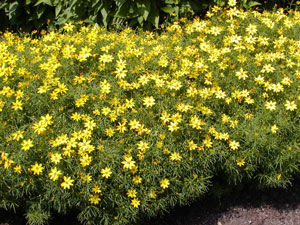 |
| Bob Lollo© |
Coreopsis (Coreopsis sp.) are prime examples of native American wildflowers that have made it to the big time. Commonly called Tickseeds, these wild members of the daisy family have long been welcomed as sturdy and colorful additions to residential yards and gardens, ideal for beds, borders and rock gardens. Besides browsing deer, coreopsis have few other pest or disease problems. The intensely yellow flowers attract butterflies, beneficial insects and birds.
There are both annual and perennial types of coreopsis suitable for residential yards. The perennial ones are cold hardy, growing as far north as the Canadian border (Zone 3). Most can handle winter temperatures as low as -20° F, possibly lower if they have good snow cover all winter. Truly versatile, they also withstand the heat and humidity of the Deep South.
Size: Various types of coreopsis range in height from 6 inches to over 2 feet. Lanceleaf coreopsis typically reaches 2 or more feet and spreads 1 to 2 feet wide when it is fully established in a year or two. Some dwarf varieties grow only 6 to 15 inches tall but may spread to 2 feet by means of stolons, stems that creep along at or just under the soil surface. Clumps of threadleaf coreopsis readily spread to 1 to 2 feet wide or more if not contained or divided regularly.
Foliage: Coreopsis leaves are quite narrow with pointed tips. They are 2 to 6 inches long, with smooth margins, and are a medium shade of green. Some grow opposite each other on the plant stems, but most of the foliage grows in a dense clump near the base of the plant. An exception is the foliage of threadleaf coreopsis which is composed of tiny, extremely narrow individual leaves along all sides of plant stems in a cloud of delicate pale green.
Flowers: The typical daisy-like coreopsis flower is 2 or more inches across and appears individually at the end of each stem. Depending on the coreopsis variety, blooms may be single, semi-double or double. They may be shades of yellow, orange or gold, some types also having brown or rusty red centers or rings. Coreopsis bloom almost all summer.

